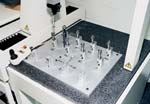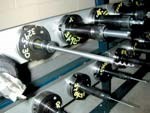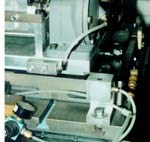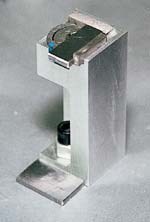Low-Cost Labor Savings
These productivity enhancements all were produced in house.
Share





ECi Software Solutions, Inc.
Featured Content
View More.png;maxWidth=45)
DMG MORI - Cincinnati
Featured Content
View More


Certain pressures don't let up just because business happens to be down. For a competitive shop to remain competitive, it has to keep on improving its efficiency.
A common way to do this is through investment. Shops purchase automation hardware, labor-saving systems and devices, and machines that do more in one setup. During slow times, however, the financial resources to make these purchases may not be there.
But other resources expand. A shop experiencing a temporary lull has more open time on its machines. Personnel may also have open time. In some cases, these resources can be directed toward creating the shop's next efficiency advance. Very often, this means engineering some custom-made piece of hardware uniquely suited to the needs of the process.
Modern Machine Shop has a special fondness for these in-house innovations. We try to cover them whenever we find them in the manufacturing facilities we visit. The problem is, we often come across these solutions while covering some larger story in that same facility. Mention of the homemade innovation might be buried in the larger article, or if space doesn't permit, it might not be included at all.
These innovations deserve a closer look. Right now, many shops feel a need to hold onto their investment capital until they see what happens next in their markets. The time to invest will return again as it has returned before, and perhaps it will return very soon. Until then, here are some labor-saving innovations that other shops have developed using the capital equipment and creativity they already had in house.
Chip Extractor
Nests of stringy chips added manual labor to parts hogged out of solid aluminum. The tendency for long chips to get caught in holes endangered taps, for example, as well as other delicate tools. For a while, the shop inserted "M00" dwell operations into the NC programs for these parts so the operator could periodically clear chips away. Unattended machining for these parts was therefore impossible.
That situation changed when the shop introduced a solution built upon a simple corkscrew. Mounting the corkscrew at the end of an extension created a tool for chip nest removal. (See Figure 1.) In place of M00 commands, NC programs now include routines during which this corkscrew tool is slowly rotated within a hole, then retracted to pull chips away. The seemingly simple tool has a tremendous impact on productivity, because the shop can now run the hog-out parts on a lights-out basis.
Unencumbered Air
Pneumatic clamping simplified setup for palletized work run on a vertical machining center. However, the pneumatic system itself had to be simple in order for this clamping to deliver true efficiency gains. If excessive piping and awkward connectors were required to get air to the actuator on the removable pallet, then the resulting system might limit the effective machining zone, or it might be frequently in need of repair.
The shop achieved the simple, reliable delivery of air pressure by taking advantage of the pallet changer's repeatable positioning. The pallet locking into the work zone now brings two mating blocks together—one block the shop affixed to the pallet and another block the shop affixed to the machine. (See Figure 2.) Both blocks have channels machined through them for conducting the air. The block on the pallet connects to the actuator; the block on the machine connects to the air supply. When they come together, an O-ring seal between them provides the closed connection.
Turning With A VMC
For one company mass-producing turned aluminum parts, a lathe is not necessarily the right type of machine for running these parts unattended. The company turns the parts using vertical machining centers instead.
The spindle holds the part. The table holds the tools. Workpieces are mounted on shanks that have the same taper as a machining center's toolholder, while the turning tools point up out of blocks that are clamped to the table. (See Figure 3.)
Turning in this way offers interesting advantages where efficiency is concerned. The system needs no workhandling automation, because the ability of the machining center to unclamp one taper and load another taper effectively provides the work handling. Also, with turning tools mounted close together on the table, the machine can make a rapid move from one tool to the next to cut "chip to chip" time to a minimum.
Universal Workholding I
The shop that uses this adjustable tombstone fixture (see Figure 4) machines short-run parts out of many different sizes of aluminum blocks. One possible way to minimize setup time might be to keep a different setup for every block size in place on various pallets. Another solution might be to drill a standard pattern of clamping holes in every block.
Creating the fixture in the photo was the solution the shop chose instead. Seven independently adjustable clamps hold blocks of various sizes.
Universal Workholding II
A screw machine shop created a CMM fixture permitting simple, single-setup inspection of any of its parts—so long as the part is ferrous. (See Figure 5.)
Each of the 12 mounting posts on the fixture has a magnet in the end. The post suspends the part above the CMM table to provide clearance for a star-shaped probe. This probe design generally allows access to any visible feature of any of the shop's parts in one setup. With the fixture providing clearance for this probe all around each part, there is rarely a reason that the probe has to be changed.
In fact, the system is designed so its users don't have to bother with much at all. Each workpiece is positioned atop the magnet using spacers that are also ferrous. The work instructions for each part include a description of how these spacers should be positioned to locate the part for inspection. The user sets the spacers and the part in place, then calls up the appropriate program.
What about the non-ferrous parts that a magnet can't grip? For these parts, the fixture needs an accessory (a piece of two-sided tape).
Setup Central
Some innovations save time just by organizing. A shop that relies heavily on custom-machined vise jaws suffered from jaw proliferation as business expanded. Operators lost time looking for the right workholding. The shop responded by putting all of this vise tooling in one place. Racks of numbered bins now hold the setup tooling. (See Figure 6.) An index attached to one rack tells operators which bin holds the tooling for each job number. An operator pulls the bin to set up a job, replaces the tooling after the job is done, and returns the bin to the rack.
Full Tilt Machining
Angled risers allow a part to be set up quickly for machining at an angle. The risers sit within a vise. Magnets embedded in the bottom edge hold the risers in place. Threaded holes along the angled edges allow stop screws to be used for part location. The risers shown in the photo (Figure 7) can hold a part at 30 degrees or 60 degrees, so angled features offset by 90 degrees can be machined in one setup. (The shop that developed these risers for its own use also sells them to other shops. See facing page for the shop's identity.)
Machines In Motion
Changing the layout of the shop floor is another way to engineer improved efficiency using resources the shop already has available. Towmotors that move work can also be used to move machines to more strategic locations.
Many shops group their machines according to function, creating a turning area, a milling area, a sawing area, and so on. This arrangement simplifies work for a maintenance technician performing routine service on similar machines, but it may not simplify the flow of parts. Transporting workpieces across the shop from one machine to the next can impair productivity not just because of the travel time, but also because it increases the likelihood that parts will begin to queue at one of those machines.
The shop in the photo (Figure 8) addressed exactly these inefficiencies with its layout. Instead of segregating machines into separate sawing and turning areas, the shop located each lathe near the saw that would provide it with blanks. Bar stock waiting to be sawed is delivered right to this spot as well. As a result, batches don't sit waiting for towmotors to come and move them to the next machine.
Related Content
How I Made It: Amy Skrzypczak, CNC Machinist, Westminster Tool
At just 28 years old, Amy Skrzypczak is already logging her ninth year as a CNC machinist. While during high school Skrzypczak may not have guessed that she’d soon be running an electrical discharge machining (EDM) department, after attending her local community college she found a home among the “misfits” at Westminster Tool. Today, she oversees the company’s wire EDM operations and feels grateful to have avoided more well-worn career paths.
Read MoreSame Headcount, Double the Sales: Successful Job Shop Automation
Doubling sales requires more than just robots. Pro Products’ staff works in tandem with robots, performing inspection and other value-added activities.
Read MoreBuilding Machines and Apprenticeships In-House: 5-Axis Live
Universal machines were the main draw of Grob’s 5-Axis Live — though the company’s apprenticeship and support proved equally impressive.
Read MoreSolve Worker Shortages With ACE Workforce Development
The America’s Cutting Edge (ACE) program is addressing the current shortage in trained and available workers by offering no-cost online and in-person training opportunities in CNC machining and metrology.
Read MoreRead Next
5 Rules of Thumb for Buying CNC Machine Tools
Use these tips to carefully plan your machine tool purchases and to avoid regretting your decision later.
Read MoreSetting Up the Building Blocks for a Digital Factory
Woodward Inc. spent over a year developing an API to connect machines to its digital factory. Caron Engineering’s MiConnect has cut most of this process while also granting the shop greater access to machine information.
Read MoreRegistration Now Open for the Precision Machining Technology Show (PMTS) 2025
The precision machining industry’s premier event returns to Cleveland, OH, April 1-3.
Read More
















































.jpg;maxWidth=300;quality=90)










